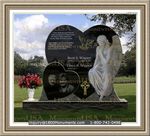|
The Memorial Program Concepts And Saying Goodbye
When you lose a loved one to death, a funeral ceremony offers a formal way to say goodbye. Such services should be personalized to reflect the life of the individual. The mortuary you use offers assistance in planning an appropriate service for your loved one.
When planning the service, consider the music you will use. You may opt for live music, through voice or instruments. Other options include the use of recorded music, which is growing in popularity.
Most of the time, there is a eulogist or officiant at the service. This individual may be a member of the clergy, a friend or family member. It is generally the responsibility of the family to communicate with the individual to officiate the service. If help is needed in contacting an appropriate individual, the mortuary can provide assistance. If planning a religious service, keep in mind some groups are more specific in what should be included than others are.
Often the individual may have been a part of a fraternal organization or served in the military. Such groups may be invited to take part in the service. Some have specific types of services, specific to their organizations. Veterans groups may offer the final playing of taps, salute to the deceased (21 gun), and present a flag to the family.
The decision to have a viewing before or after the service is at the digression of the family. In some locations, the viewing is considered traditional, while in others it is not. Regardless of local tradition, the family has the final say in these regards.
Saying goodbye to a loved one who has passed is often difficult emotionally, but, for many, an important part of the grieving process. Plans for a funeral ceremony should be discussed before the loved one passes if possible. This allows you to plan a service you know your loved one would have approved.
|
|



























